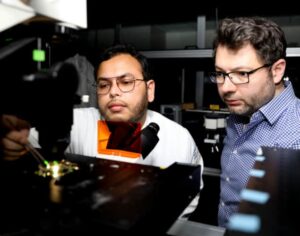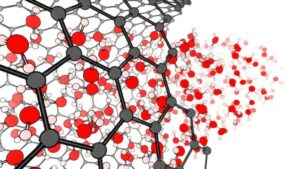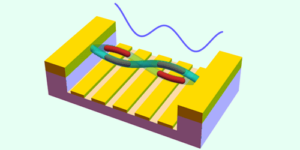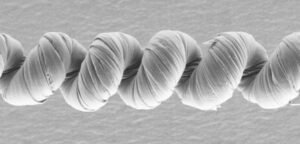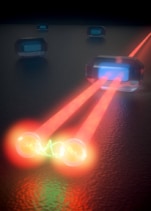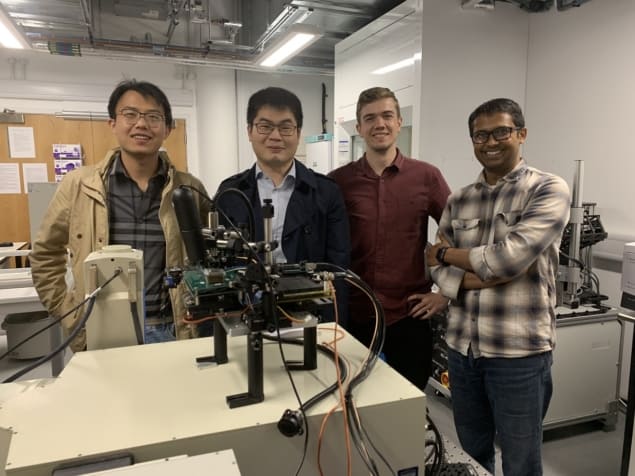
The miniaturization of instruments to make them portable and convenient for use outside the laboratory is one of the greatest challenges for developing analytical tools. Reporting in Science, researchers from the UK, China and Finland, led by Tawfique Hasan at the University of Cambridge in the UK, present a device that measures the energy of incoming photons, yet is only a few micrometres long with a width of a couple of hundreds of nanometres. The ultracompact microspectrometer could benefit a wide range of applications, from centimetre-scale samples down to microscopic biological samples, such as single cells.
For the spectrometer, the researchers used a nanowire made from a semiconductor with a composition that gradually changes from one end to the other. Semiconductors only absorb photons with higher energy than a threshold determined by physical properties that depend on the chemical composition. As a result, the gradually changing composition of the nanowire along its length leads to different energy thresholds at different positions. The energy resolution is achieved by placing closely spaced electrodes along the nanowire each probing a different position over the gradient of bandgaps.
Spectrometers generally work with monochromatic (i.e., single-colour) or broad-band (i.e., multi-colour) light sources. The new single-nanowire spectrometers show excellent performance in both cases despite their very small size. In addition, the study shows that the technical specifications, such as the spectral resolution, are comparable with those of commercial instruments. Moreover, the researchers discuss that by using different materials to make the semiconductor nanowires, it is possible to cover a wide range of the electromagnetic spectrum from ultraviolet to infrared light sensing.
How far do the wires reach?
The researchers used the spectrometer on a centimetre-scale object. After reconstructing the signals, the data provided was consistent with the imaged object and in good agreement with commercial spectrometers.

Nanowire research grows up
To satisfy the demands of biomedical applications, the spectrometer also needs to work well on micrometer-scale samples, which the researchers demonstrated using naturally coloured red onion cells. Even though the step size in imaging is limited to about one micrometre, the researchers believe that by combining their spectrometer with advanced scanning systems, much higher image resolutions are possible within the same amount of time.
“The primary significance of our result is not the demonstration of the nanowire-based spectrometer itself but that it represents, arguably, the simplest possible spectrometer platform,” says Hasan. “Any family of light-sensitive materials with closely spaced bandgaps can now be used in a spectrometer. By using these simple platforms, we can also bypass the need for miniaturizing other optical elements in the spectrometer.”
Full details are reported in Science.
- SEO Powered Content & PR Distribution. Get Amplified Today.
- PlatoData.Network Vertical Generative Ai. Empower Yourself. Access Here.
- PlatoAiStream. Web3 Intelligence. Knowledge Amplified. Access Here.
- PlatoESG. Automotive / EVs, Carbon, CleanTech, Energy, Environment, Solar, Waste Management. Access Here.
- BlockOffsets. Modernizing Environmental Offset Ownership. Access Here.
- Source: https://physicsworld.com/a/single-nanowires-make-powerful-spectrometers/
- :is
- :not
- 80
- 90
- a
- About
- AC
- achieved
- Adam
- addition
- advanced
- After
- Agreement
- along
- also
- amount
- Analytical
- and
- applications
- ARE
- arguably
- AS
- At
- BE
- believe
- benefit
- biomedical
- both
- but
- by
- cambridge
- CAN
- cases
- Cells
- challenges
- Changes
- changing
- chemical
- China
- closely
- combining
- commercial
- comparable
- consistent
- Convenient
- could
- Couple
- cover
- created
- credit
- data
- demands
- demonstrated
- Despite
- details
- determined
- developing
- device
- different
- discuss
- do
- down
- e
- each
- elements
- end
- energy
- Even
- excellent
- family
- far
- few
- Finland
- For
- from
- generally
- good
- gradually
- greatest
- Grows
- higher
- http
- HTTPS
- Hundreds
- i
- image
- Imaging
- in
- Incoming
- information
- instruments
- issue
- IT
- ITS
- itself
- jpg
- laboratory
- Leads
- Led
- left
- Length
- light
- Limited
- Long
- made
- make
- materials
- max-width
- measures
- Moreover
- much
- Need
- needs
- New
- now
- object
- of
- on
- ONE
- only
- or
- Other
- our
- outside
- over
- performance
- Photons
- physical
- Physics
- Physics World
- placing
- platform
- Platforms
- plato
- Plato Data Intelligence
- PlatoData
- position
- positions
- possible
- powerful
- present
- primary
- properties
- provided
- range
- reach
- Red
- Reported
- Reporting
- represents
- research
- researchers
- Resolution
- result
- right
- same
- says
- scanning
- semiconductor
- Semiconductors
- show
- Shows
- signals
- significance
- Simple
- single
- Size
- small
- Sources
- specifications
- Spectral
- Spectrum
- Step
- Study
- such
- Systems
- Technical
- than
- that
- The
- the UK
- their
- Them
- These
- those
- though?
- threshold
- thumbnail
- time
- to
- tom
- tools
- true
- Uk
- university
- university of cambridge
- use
- used
- using
- very
- was
- we
- WELL
- which
- WHO
- wide
- Wide range
- with
- within
- Work
- world
- yet
- zephyrnet

